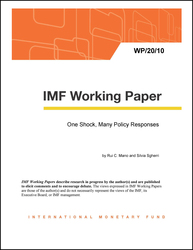
One Shock, Many Policy Responses
Policymakers have relied on a wide range of policy tools to cope with capital flow shocks. And yet, the effects and interaction of these policies remain under debate, as does the motivation for using them. In this paper, quantile local projections are used to estimate the entire distribution of future policy responses to portfolio flow shocks for 20 emerging markets and understand the variety of policy choices across the sample. To assuage endogeneity concerns, estimates rely on the fact that global capital flows are exogenous from the viewpoint of any one of these countries. The paper finds that: (i) policy responses to capital flow shocks are heterogeneous across countries, fat-tailed—“extreme” responses tend to be more elastic than “typical” responses—and asymmetric—“extreme” responses tend to be more elastic with respect to outflows than to inflows; (ii) country characteristics are linked to policy choices—with cross-country differences in forex intervention relating to the size of balance sheet vulnerabilities and the depth of the forex market; (iii) the use of targeted macroprudential policy and capital flows management measures can help “free the hands” of monetary policy by allowing it to focus more squarely on domestic cyclical developments.
Publication date: January 2020
ISBN: 9781513521503
$18.00
Add to Cart by clicking price of the language and format you'd like to purchase
Available Languages and Formats
| English |
Prices in red indicate formats that are not yet available but are forthcoming.
Topics covered in this book
This title contains information about the following subjects.
Click on a subject if you would like to see other titles with the same subjects.
Capital flows , emerging markets , macroprudential policies , capital flows management , , WP , policy response , policy tool , flow pressure , forex , policy action
Summary
Copyright © 2010 - 2025
Powered by:
AIDC



